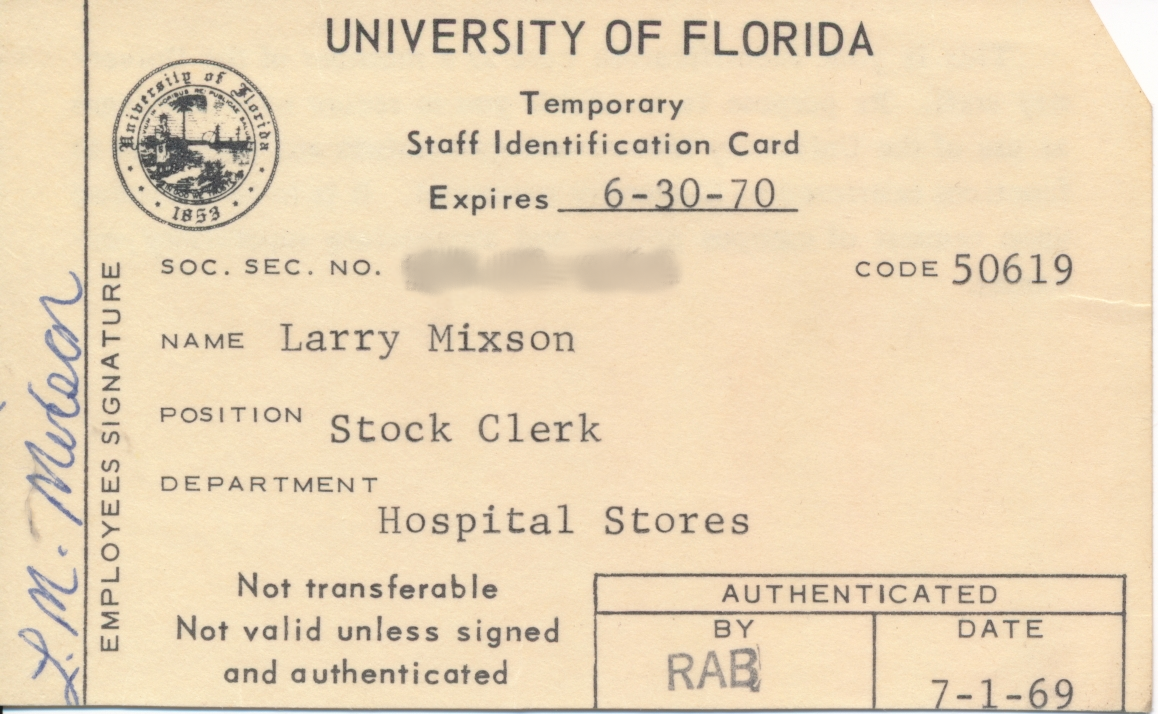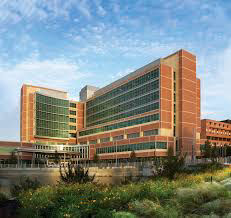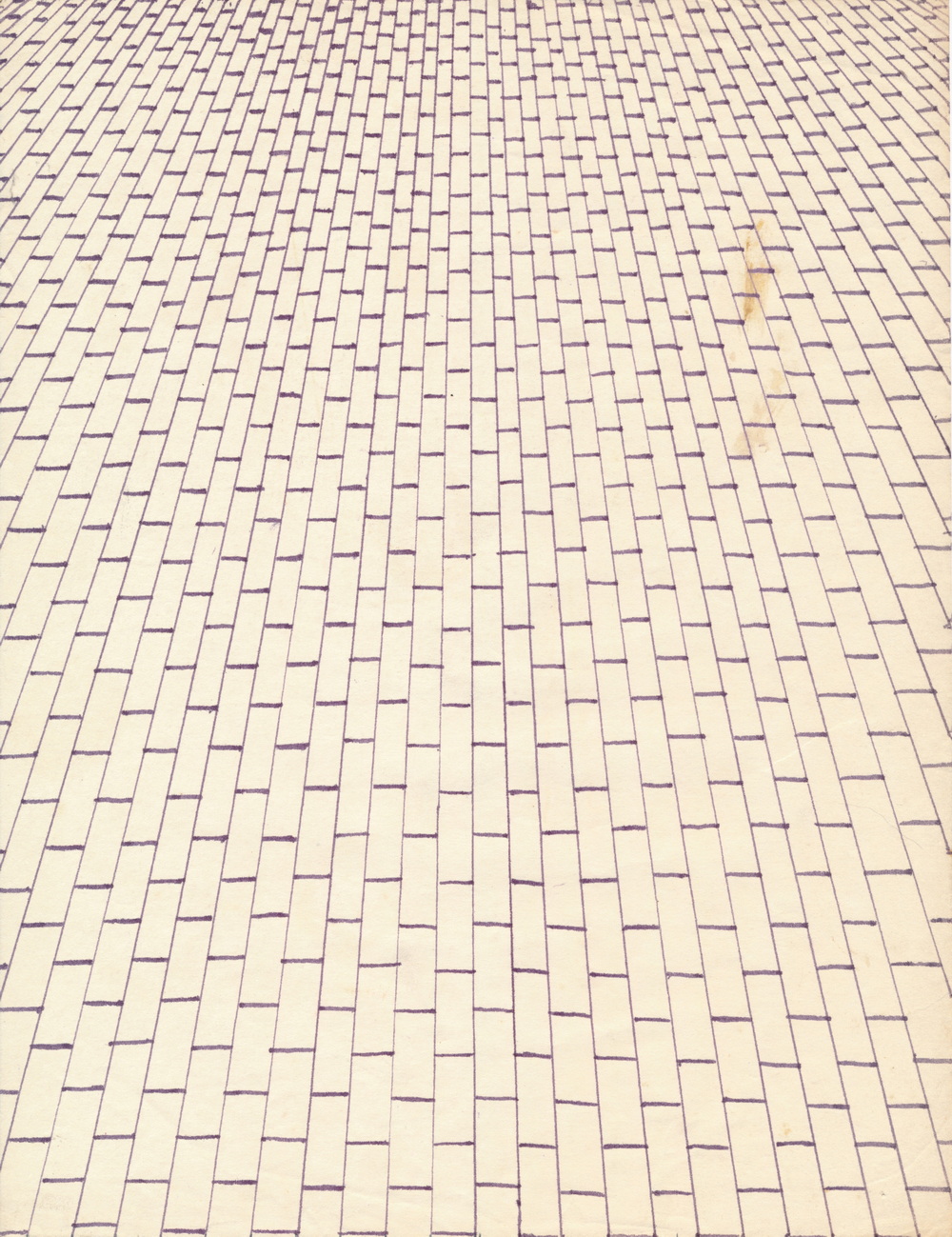


1969
My First Job

In January, after getting out of school at noon, both Brenda and I got jobs at the University’s Shands Medical Center working from one to five on weekdays with me making $1.45 an hour. When school let out, I would meet Brenda at her yellow Camaro in the senior parking lot and we either go home and eat lunch or stop and get a hamburger then go to work. While Brenda worked as a clerk in the Hospital Medical Records department while I was a stock clerk in in Hospital Supplies, I on the other hand had the lowest of low jobs in the hospital, both figuratively and physically with Hospital Supplies not being in the basement, but the sub-basement, B2 on the button on the one elevator that went that far down into the bowls of the hospital.
 Shands
Medical Center
Shands
Medical Center
1969
The manger Hospital Supplies was Bob Boulware, a longtime acquaintance my Dad, with them knowing each other from childhood, both growing up in Flemington and going Reddick High School. Bob and Dad worked out a deal with Bob hiring me as a student stock clerk and Dad hiring his son as a student stock clerk in the Chemistry Department. There were several full time men that worked in Hospital Stores at the time, both who I thought as being ancient, probably in their 60’s, both with shriveled up skin, thinning hair, chain smokers with tobacco stains on their hands, and brown teeth. One was Mr. Smith and the other was just called Sarge, no first name, no last name, no Mister, just Sarge. Every day at lunch they played checkers while they ate the lunches they had brought from home. Mr. Smith usually worked at the front counter while Sarge handled shipping and receiving. There also was older, but not as ancient, black man, Mr. Jones, who worked the receiving dock where supply shipments would be dropped off. In addition to me there were other student stock clerks, usually two or three, working different, but often overlapping hours, later even my brother David worked there after I had left.
 My
doodle art inspired by looking up at brick wall, 1969
My
doodle art inspired by looking up at brick wall, 1969
To understand my job, you have to understand the size and scale of the hospital, or just Shands, as we called it. Shands had several interconnecting buildings from five to eleven stories tall with the newest addition having a solid brick exterior wall the size of a football field stood on end without a single window, an amazing expanse of brick. I would sometimes stand under it upon arriving or leaving work and gaze up with the brick going off into the sky. [drawing, brick] Several hundreds if not a thousands of people worked at Shands in addition the many patients. A hospital complex of this size requires a tremendous amount of supplies, supplies of every kind. Not only were there is the typical supplies, toilet paper, paper towels, soap, cleaning products, and so on, but there were the medical supplies, bandages, gauze, bed linens, operating room stuff, paper, pens, tanks of oxygen, nitrous oxide, iodine, alcohol, the list was endless, thousands of items. Hospital Stores not only took most of the basement, B1, but the entire sub-basement, B2 with each being the half the size of a football field. The B1 level had twenty or so rows of shelves fifty feet long and eight feet tall filled with every imaginable item with, boxes piled high on the top of the shelves. If you ever been in Home Depot, well that is what B1 level was like, but with rows much closer together. The B2 level on the other hand was for bulker items, boxes from the size of small suitcases to as large as a small refrigerator. The boxes were stacked on pallets in rows, many of feet of boxes for one item, stacked eight or ten feet high, rows upon rows of boxes. Hospital Stores was well organized, it had to be with thousands of items, each row, section, shelf on the B1 level was marked, and down in the B2 level was laid out in a grid with row and section numbers, everything had its place.
The supplies were tracked by a card catalog system much like the card catalog at a library. Humm, okay, younger people wouldn’t know about that would you with library catalogs being computerized these days. Imagine a thousand of 5 by 8 inch paper cards, one for each item in the storerooms, stored in a cabinet with many pull out drawers to hold them. As the items were received, the quantity was record on the card and when items were removed from the storeroom the number were recorded on the cards, all by hand. The last few months I worked there they were converting to a computerized system, but still using the card system in parallel. Mr. Boulware and Mr. Smith had their doubts about the new computer system and were always complaining about it. At the same time Dad was doing the same computerization of the inventory at the Chemistry Department stockrooms.
Supplies would be delivered by truck to the loading dock, Mr. Jones would receive them, count the boxes, and confirm it matched the packing slip, and them move the items from the dock into the receiving area where Sarge would open the boxes, count the individual items, determine the item storage location, level, row, section, shelf, write it on a card and have the stock clerks put the items in their place. Several trucks would come each day, some small, some full size semi-trailer trucks that might have a hundred boxes of larger items.
As a stock clerk I took orders from Sarge, he would show me a pile of items in the receiving area, give me a card of where they were to go and then I would get a metal cart, put the items on it, and then go about the many rows putting the items on the shelfs on the B1 level. For the bulkier items stored in the B2, sub-basement there was on opening in the floor of B1 with a wooden staircase leading down to the sub-basement. Along one side of the stair steps were a couple of wood planks making a downward ramp. To get items from B1 to B2 one stock clerk would be at the top dropping the boxes down the ramp while another stock clerk would be at the bottom to catch the boxes, sometimes a precarious job for the person on the receiving end for the larger or heaver boxes. Once the boxes were in the basement, we would move them to the correct location and stack them. The sub-basement was a maze of boxes, stacked in some places ten feet tall. One time another clerk and climbed up on a pile of stacked boxes thirty feet long, fifteen feet wide and ten feet tall and moved a few around making a place we could hide out and play cards when things were slow which worked pretty well until one day we were there and we hear a voice, “Shouldn’t you boys be working?” It was Mr. Boulware, we had been discovered. We were a bit more careful about taking breaks after that.
After working in Hospital Stores for six or nine months I was called over one day by Mr. Smith and said their regular delivery employee was out sick and he needed me to make some deliveries within the hospital. Each floor and unit in the hospital had a nurse station, if you ever been in a hospital as a patient or visiting you know what it looks like, an area with a counter and desks for the nurses with shelves and cabinets with the needed supplies for treating patients which of course needed regular resupply. The nurses would send a list of needed supplies to Hospital Stores which a stock clerk would go gather from the many shelves in the storerooms or in the sub-basement and put them on a double decker metal cart. I had gathered the supplies before, but this was the first time I actually made a delivery, East Wing, floor three nurse station, the order said. I filled the cart, Mr. Smith checked to make sure I got it all correct and then I set off wheeling the cart down the maze of hallways. After taking the wrong elevator, for there were many elevators in the hospital, I finally got to the correct nurse station, unloaded the supplies, got a signature, and returned to Hospital Stores. One of the more interesting deliveries I made was to the Intensive Care Unit (ICU) which had patients out of surgery. As it turns out my best friend, Bill, mother worked as an ICU nurse and when she saw me, she greeted me friendly and showed me where to put the supplies. I found ICU gruesome, patients hooked up to so much medical equipment and in so many bandages you could hardly tell it was a person. Bill’s mother pointed to one patient saying he was in a motorcycle accident the day before and was expected to die any time. She then asked if I wanted to see an operation, I was like, yeah, that would be interesting, and she led me down a hallway, up a short stairs into, with it being a teaching hospital, an observation room that overlooked a surgery in progress. I watched for a few minutes before I started feeling a little sick to my stomach and left, returning back to Hospital Stores.
Updated: 12-04-2022